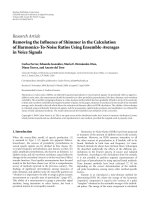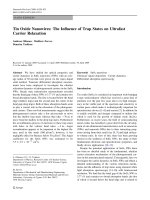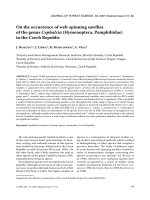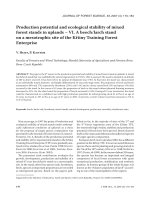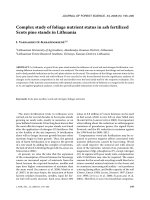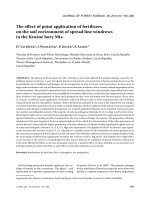Báo cáo lâm nghiệp: "Preliminary study on phloemogenesis in Norway spruce: influence of age and selected environmental factors" ppsx
Bạn đang xem bản rút gọn của tài liệu. Xem và tải ngay bản đầy đủ của tài liệu tại đây (388.11 KB, 7 trang )
226 J. FOR. SCI., 57, 2011 (5): 226–232
JOURNAL OF FOREST SCIENCE, 57, 2011 (5): 226–232
Preliminary study on phloemogenesis in Norway spruce:
infl uence of age and selected environmental factors
G. V, H. V, V. G, L. M
Faculty of Forestry and Wood Technology, Mendel University in Brno, Brno, Czech Republic
ABSTRACT: The process of phloem formation in Norway spruce (Picea abies [L.] Karst.) was analysed during the
growing season 2009 in Rájec-Němčice locality (Czech Republic). The research series consisted of research plots
with 34 and 105 years old spruce monocultures. The formation of phloem cells was determined by the examination of
small increment cores taken once a week. Cross-sections of tissues were studied under a light microscope. Cambium
activation was observed on 9 April both in young and old trees. On the same date the first newly formed cells of early
phloem were observed in old trees but in young trees one week later. Although the time of early phloem formation
was 14 days longer in old trees, there were no large differences in the numbers of formed cells. The beginning of the
longitudinal axial parenchyma formation was determined in young trees on May 14. In old trees this activity was seen
a week later. The influence of air temperature and soil moisture was also analysed in relation to phloemogenesis.
Keywords: cambium; environmental factors; influence of age; light microscopy; Norway spruce (Picea abies); phloem
formation
Supported by the Ministry of Education, Youth and Sports of the Czech Republic, Project No. MSM 6215648902, and
by the Ministry of the Environment of the Czech Republic, Project No. SP/2d1/93/07, and by the Mendel University
in Brno, Project No. IGA 17/2010.
e growth of multicellular organisms is seen
as the increase in an individual’s volume condi-
tioned by the creation of new cells. is leads to
an irreversible process of the expansion of plant
dimensions. Secondary growth is referred to as
radial growth and is conditioned by cambial activ-
ity (L 1994; P et al. 1998). e
cambium is a secondary meristem, which divides
the phloem cells centrifugally and xylem cells cen-
tripetally (Z, B 1971; L
1994). Cambial activity and secondary growth in
temperate regions are periodic, alternating periods
of growth with winter inactivity (F et al. 1999).
e number of phloem mother cells produced
during the season is much smaller than that of
those produced on the xylem side (Z,
B 1971). During periods of active cambial
growth each xylem mother cell divides to form two
daughter cells, which in turn divide once, resulting
in the formation of a set of four cells, all of which
eventually mature into xylem cells. Phloem mother
cells are produced on the phloem side of the cam-
bium, and these divide only once to form a pair of
cells (M 1970; I, L 1973).
is partially explains why less bark than wood is
always formed (P, Z 1980). How-
ever, from the physiological point of view, the de-
velopment of new phloem cells is as important as
the development of xylem cells, maybe even more
important. e phloem is a tissue specialized in the
translocation of assimilates which are essential for
the nutrition of heterotrophic, non-photosynthe-
sizing parts of plant and also for the storage ma-
terials (E 2006). e phloem consists of pa-
renchyma cells and sieve-tube cells (P,
Z 1980).
Both phloem and xylem cells are subjects of
secondary growth, but there are considerable dif-
ferences in the process of their development. e
processes of xylogenesis are more aff ected by the
changes in climatic conditions; therefore, the struc-
ture of a tree ring represents a kind of climatic data
archives. is serves as a basis for the fi eld of den-
droclimatology (S 1990; K,
J. FOR. SCI., 57, 2011 (5): 226–232 227
S 1995). e development of phlo-
em is probably more aff ected by endogenous fac-
tors than the development of xylem (G,
Č 2008). A possible cause can be the fact that
only the cells which developed in the current veg-
etation period are functional in the phloem, the
older ones are compressed and thus non-functional
as a consequence of the secondary growth of the
stem (P, Z 1980). at is why the
creation of new phloem cells is vital for the tree as
otherwise the entire individual would die. is is in
contrast to xylem, where even the cells developed
in previous periods perform their physiological
functions, although most of them are dead. is
leads to the fact that the variability of xylem cell
formation in the last tree ring does not aff ect the
function of xylem tissues as a whole considerably.
e conducting phloem of Pinaceae consists of
living, mature sieve cells and various types of pa-
renchyma cells. Within each growth increment, the
phloem parenchyma strands are arranged in a more
or less conspicuously interrupted tangential band,
usually one or two cells in radial direction, as seen
in transverse section. e portion of each growth
increment external to the parenchyma strands has
been designated early phloem, and the remainder
of the growth increment late phloem (A,
E 1973).
e variability of the anatomical structure and
phloem and xylem increment widths in relation to
growth conditions was described in experiments
when changes in these characteristics of Norway
spruce (Picea abies [L.] Karst.) were observed in
controlled conditions. Experiments with the con-
trolled warming and cooling of a part of the Nor-
way spruce stem proved that the phloem increment
contains more cells of late phloem if the cambial
activity fi nishes later (G 2007). is research
demonstrated that the rate of phloem cell forma-
tion was stable regardless whether the cambium
was cooled, warmed up or unaff ected. On the xylem
side, the temperature had a signifi cant infl uence on
the cell production in the initial stage of the vegeta-
tion period, whereas the other factors, which were
not considered, exerted probably the main eff ect
during the formation of late xylem (G 2007).
is means that the formation of phloem cells in
the stem of Norway spruce is very homogeneous
and does not manifest any signifi cant deviations of
growth. erefore, it is useful to describe the dy-
namics of phloem formation in quite a detail, at the
cell level. To verify this hypothesis, the objective of
our research was to analyse the impact of external
factors on the formation and development of phlo-
em cells. Further, the infl uence of an internal factor
– age – on the phloem cell formation was explored.
MATERIAL AND METHODS
e samples of phloem were taken from stems of
Norway spruce (Picea abies [L.] Karst.) at a fi eld
research station of the Department of Forest Ecol-
ogy, Mendel University in Brno. e plots were
located about 30 km to the north of Brno (coor-
dinates 49°29'31''N, 16°43'30''E). e research plot
Rájec-Němčice is located in Natural Forest Area 30
Drahanská vrchovina. It is a considerably forested
region (668 km
2
= over 40% of its total area) cover-
ing mainly the highlands Drahanská and Konická
vrchovina as well as the Moravian Karst of Devo-
nian origin and a part of the Adamovská vrchovina
highland. As regards the type of relief, this is a part
of broken highlands of folded and faulted structures
and intrusive igneous rocks of Czech highlands. e
bedrock is intrusive igneous acid granodiorite of
the Brno Massif (K, M 1992); the soil
is oligotrophic modal Cambisol with moder form
of forest fl oor (M et al. 2009; F et al.
2009). e plots are at the altitude of 600–660 m
a.s.l. and the climate is temperate (Q 1971). As
regards climatic parameters, the average annual air
temperature is 6.5°C and the average annual pre-
cipitation is 717 mm (H 2002). e forest type
is Abieto-Fagetum mesotrophicum with Oxalis ace-
tosella (5S1) (P 1987).
Our study was conducted on two adjacent re-
search plots (spruce monocultures) diff ering in
age. e fi rst stand (of the second generation af-
ter mixed forest) was 34 years old, the second one
(of the fi rst generation after mixed forest) was 105
years old. ese two stands were used for sampling
for the purposes of our research. e basic dendro-
metric characteristics of both stands, characterized
by average values, are presented in Table 1.
From each stand six trees with values close to the
mean tree of the stand were chosen. Samples in the
form of microcores were taken in regular weekly
intervals. e microcores (cylinders of 1.8 mm in
diameter and 1.5 cm in length) were taken by means
of a specialized increment borer – Trephor (R
Table 1. e basic dendrometric characteristics
Breast-height
diameter (cm)
Tree
height (m)
Crown base
height (m)
Young stand 22.5 17.6 8.0
Old stand 36.9 35.3 20.1
228 J. FOR. SCI., 57, 2011 (5): 226–232
et al. 2006). Sampling was conducted at the height
of 1.3 m ± 20 cm. It means the fi rst sample was taken
at 1.10 m (the space division was calculated with the
consideration of the number of planned samplings
and their layout). Individual samplings continued
upwards, always in the angle of 20–30 degrees
from the previous one, 2 cm far from each other.
e resulting shape of sampling spots was a spiral
around the stem.
Samples, put separately in histological cassettes,
were immersed into FAA (formaldehyde-acetic ac-
id-ethanol) fi xative solution for a week. For longer
storage, the samples were immersed into the solu-
tion of 96% ethanol and distilled water at the ra-
tio of 30:70. Before further processing, redundant
wood and bark were cut off , and then the samples
went through an alcohol series consisting of etha-
nol of various concentrations and xylene. e rea-
son for this step is the preparation for the stage
when the samples are impregnated in paraffi n so
that they could be cut using the rotation micro-
tome. Paraffi n is not soluble in water, therefore the
samples are dehydrated by ethanol. en the etha-
nol has to be displaced by xylene which is mixable
with paraffi n. e samples are left in paraffi n for
four hours at least. Times of the soaking of micro-
cores before paraffi n impregnation were 1.5 h for
(ethanol 70%, ethanol 90%, ethanol 95%, ethanol
100% and xylene).
e samples were put in metal moulds, with the
cross-section (the darker part) towards the bottom,
and the moulds were fi lled by means of paraffi n dis-
penser (Leica EG 1120). When it cooled down, the
paraffi n block was taken out of the mould and cut
using the rotation microtome (Leica RM 2235) so
that a part of the microcore was uncovered. e
microcores were then immersed into water over-
night for repeated hydration so that they could be
cut more easily on the microtome. Subsequently,
microsections of 12 µm in thickness were pro-
duced using the rotation microtome; they were
laid on water surface (40°C). is straightened the
microsections, which could be then taken out and
mounted on glass slides with glue (egg white and
glycerine). e slides with specimens were dried
for 5 minutes at the temperature of 60°C and then
dried completely in the air. Further, the specimens
went through another alcohol series, this time con-
nected with staining. To highlight the non-lignifi ed
parts, Astra Blue stain was used and to highlight
lignifi ed parts safranin was used. To achieve the
better colour of lignifi ed cell walls safranin was
used at fi rst separately and then in a solution with
Astra Blue. Times of microsection soaking be-
fore closing the specimen were 10 min for (etha-
nol 96%, xylene), 2
+
h for (safranin), and 5 min for
(safranin + Astra Blue).
e specimens were closed with Canadian bal-
sam and a cover slip. Cover slips of the resulting
microscopic specimens were loaded down with
rubber plugs for 14 days.
e fi nished microscopic specimens were used
to analyse the process of new cell development
and their gradual diff erentiation. In each specimen
three radial series of cells in the phloem part were
selected and the number of the cells contained was
counted. e presence of the following types of
phloem cells was examined: early phloem, longitu-
dinal parenchyma and late phloem.
Subsequent evaluation and further processing of
results consisted of these steps: description of the
phloem formation in relation to temperatures; defi -
nition of the trend of phloem cell growth; and the
investigation of specifi c correlations between cell
growth and meteorological data.
Moreover, the diff erence between the individuals
from the young and the old stands was studied so
that the infl uence of age could be analyzed.
Biotic environmental factors are measured on
these plots regularly, and temperature and humid-
ity aspects are measured every day. To analyse the
impact of external environmental factors on the
formation of phloem cells we used meteorological
measurements of the Department of Forest Ecol-
ogy. e following factors were measured con-
tinually: air temperature at 2 m above the ground,
measured in hourly intervals, and soil moisture
measured by means of soil moisture sensors CS 616
(Campbell Scientifi c, USA) at the depth of 30 cm,
in hourly intervals (R et al. 1989). Soil tem-
perature was measured at the depth of 10 cm and
30 cm, in hourly intervals by means of Pt100/8 soil
temperature sensors (EMS Brno, Czech Republic).
For each day on which the samples for phloemo-
genesis analysis were taken (in weekly intervals) the
average values of climatic data were established.
ese values were matched with the found number
of cells and the relationship between them was exam-
ined by means of non-linear regression. Michailov’s
growth function was used (K et al. 1972).
RESULTS AND DISCUSSION
e starting cambial activity in specimens is mani-
fested by radial expansion of cells, slight narrowing of
their tangential cell walls and sometimes by a well vis-
ible cell content. After a few days, their number rises
J. FOR. SCI., 57, 2011 (5): 226–232 229
and then the fi rst phloem and xylem cells are diff eren-
tiated. e interval between the cambium activation
and the fi rst phloem tissue cell diff erentiation varies
in diff erent trees. We assign the beginning of cambial
activity to the date of April 9
(−7 days +0 days, as sam-
ples were taken in regular weekly intervals – it applies
to all dates mentioned). e growth of the number of
cells was visible in some trees on that very day, how-
ever, in others only a week later, i.e. on April 16. In the
week before April 9 the temperature did not fall below
4.9°C and in the week before April 16 the temperature
did not fall below 6.2°C.
In all trees early phloem cells were found out be-
fore the beginning of cambial activity. ese cells
were formed at the end of the previous vegetation
period. As regards the newly formed early phloem
cells (EP), there were distinct diff erences between
young and old trees. Whereas in young trees new
early phloem cells started to appear on April 16, in
old trees they were present on April 9.
e end of early phloem formation is characterized
by the beginning of longitudinal axial parenchyma
(AP) formation. It was observed on May 14 in young
trees. In the week before minimum and maximum
temperature was 5.3°C and 23.2°C, respectively. In
old trees this activity was seen a week later, after a
week with minimum and maximum temperatures
being 6.5°C and 20.7°C, respectively. Although the
time of EP formation was 14 days longer in old trees,
there were no large diff erences in the numbers of
formed cells. On average, there were four cells in the
radial direction, both in old and young trees.
After one cell of axial parenchyma on average
was formed, the formation of late phloem started.
In young trees it was fi rst observed on May 14, in
old ones on May 21. is means the late phloem
started forming very soon after the fi rst cells of axi-
al parenchyma and its production continued till the
second half of September, both in young and old
trees. On average, 3.3 cells were formed in young
trees and 3.6 in old trees. e graph of the process
is shown in Figs. 1–3.
When assessing the growth trend, at fi rst the
growth of early phloem, axial parenchyma and late
phloem were evaluated separately, and then as a
whole. Fig. 1 shows that in young trees the forma-
tion of new EP cells starts approximately a week
later and ends approximately a week earlier than
in old trees. However, the increase in the number
of cells is much faster and as a result the numbers
of cells in this type of tissue are the same on both
plots. When AP is formed, the rate of the increase
gets balanced. As regards LP, there is a faster de-
crease in the formation of new cells in young trees.
Although the period when LP is formed is longer in
young trees (the formation starts sooner), the de-
crease in the formation of these cells leads to the
fact that the resulting number of cells is lower than
in old trees.
e curve of the total number of newly formed
cells (without distinguishing between axial paren-
chyma and phloem) is S-shaped for old trees, but
not for young trees (Fig. 4) as the growth is faster at
the beginning of the vegetation period and then the
growth stagnation comes earlier, at around mid-July.
e cell growth is more aff ected by the tempera-
ture of several preceding days, not only by the tem-
perature around the sampling day. erefore, we
did not take into account the average temperature
of the previous day only, but also the average tem-
perature of the previous week and the average tem-
perature of the preceding three days.
When the relation between soil moisture and the
number of cells was studied, no dependences were
confi rmed. On the other hand, when investigating
the relationship between air temperature and the
number of cells, we found the following depen-
dences, where the values show the determination
coeffi cients for Michailov’s growth function.
e table shows a positive relationship between
air temperature and the formation of cells.
At the beginning of the examined vegetation pe-
riod, before the start of cambial activity, we found
out that 1–2 early phloem cells remained from the
young trees
old trees
28/1 7/4 7/5 27/5 16/6 6/7 26/7
Date
Fig. 1. Comparison of the growth dynamics of phloem
tissue
∙ C – beginning of cambial activity
- - EP – early phloem formation
AP – axial parenchyma formation
▔
LP – late phloem formation
230 J. FOR. SCI., 57, 2011 (5): 226–232
4.00
5.00
6.00
7.00
8.00
9.00
10.00
No. of cells
LP AP EP
0.00
1.00
2.00
3.00
8/3 27/4 16/6 5/8 24/9
Date
2.00
3.00
4.00
5.00
6.00
7.00
8.00
9.00
10.00
No. of cells
LP AP EP
0.00
1.00
8/3 27/4 16/6 5/8 24/9
Date
Fig. 2 e growth of phloem
tissue in young trees.
EP – early phloem formation,
AP – axial parenchyma for-
mation,
LP – late phloem formation
Fig. 3. e growth of phloem
tissue in old trees
EP – early phloem formation,
AP – axial parenchyma for-
mation,
LP – late phloem formation
R² = 0.9597
R² = 0.9899
3.00
4.00
5.00
6.00
7.00
8.00
9.00
10.00
No. of cells
young trees
0.00
1.00
2.00
3.00
8/3 27/4 16/6 5/8 24/9
Date
young trees
old trees
Fig. 4. e overall growth trend
of young and old trees with the
determination coefficients of
fi tted curves
previous vegetation period. is is in agreement
with the results of research conducted in Slovenia
(G 2007). One of the Slovenian research plots
was located in an area where spruce is not autoch-
thonous – Pokljuka; the second research plot was
in an area where spruce grows naturally ‒ Sorško
polje. e dendrometric parameters of the trees
from both these plots correspond to the values of
the older plot of Rájec-Němčice research site. at
is why we compared the results of G (2007)
with the results from our older plot only.
G (2007) stated that the number of cells in
the cambial zone doubled at the very beginning of the
vegetation period, which was considered the begin-
ning of cambial activity. e trees in the Czech Re-
public manifested this increase only in the second
J. FOR. SCI., 57, 2011 (5): 226–232 231
part of the vegetation period (around mid-May);
therefore, it could not be considered as the beginning
of cambial activity. We can conclude that the increase
in the number of cambial zone cells is highly variable.
Because the transition of cambium from the dormant
state to the active one is a matter of several days (W-
1964), it is very diffi cult to identify this moment;
especially due to the fact that the periodical sampling
was performed in weekly intervals.
In our research, the start of the formation of new
early phloem cells was observed at the beginning
of April. In Slovenia, new cells started to appear in
the fi rst week of May on both plots (G 2007).
What was similar to our fi ndings – it happened
very soon after the cambial activity was observed.
Axial parenchyma started to appear in Czech trees
in the second half of April as well as the fi rst cells of
late phloem. In Slovenian trees axial parenchyma was
observed to start appearing in mid-May on the plot
with autochthonous spruce, and at the end of May on
the plot where spruce is not autochthonous. Late pa-
renchyma started to appear in Slovenian trees of both
plots as late as at the beginning of June (G 2007).
In spite of large diff erences in the growth of phlo-
em cells in Czech and Slovenian spruce trees, the
number of cells in the particular types of tissue is
the same for all three plots. e described diff er-
ences are presented in Fig. 5.
We can assume that the diff erence in the growth
dynamics of young and old trees is caused by the
thickness of bark which has a heat-insulating func-
tion. Young trees have a thinner bark, that is why
living tissues respond more to the fl uctuation of
external conditions. A possible cause of the faster
growth of phloem cells may be the smaller number
of formed cells within the entire stem.
CONCLUSION
When assessing the infl uence of three selected fac-
tors (average daily temperature and soil moisture as
external factors, and age as an internal factor) on the
formation of cells, some diff erences were observed.
No correlation was found for the relation with soil
moisture at the depth of 30 cm. We found a medium
up to strong correlation for the relation with average
air temperature at 2 m above the ground. As regards
the factor of age, the fi nal numbers of cells of par-
ticular tissues (EP, AP, LP) did not diff er consider-
ably, however, there were diff erences of weeks in the
timing of the formation of the tissues. It means that
the factor which describes the variability of phloem
tissue growth when comparing young and old trees
is not the number of cells but the timing of their for-
mation. When the results obtained in the old stand
were compared with the results of other authors, it
was found out again that the diff erences in timing
were more signifi cant than the diff erences in the
number of formed cells.
To conclude, the number of cells is not the only
important aspect for the description of the phloem
cell formation. e timing of their formation, it
means the time when the transport of assimilates
can start or when storage materials start to arise in
the phloem in the form of axial parenchyma, is of
the same or even higher importance.
R efer e nce s
A F.J., E R.F. (1973): Structure and seasonal
development of the secondary phloem in the Pinaceae.
Botanical Gazette, 1: 17.
E R.F. (2006): Esau's Plant Anatomy, Meristems, Cells,
and Tissues of the Plant Body: eir Structure, Function,
and Development. New Jersey, John Wiley & Sons: 601.
F T., M L., T I., K J. (2009):
Eff ects of spruce, beech and mixed commercial stand on
humus conditions of forest soils. Journal of Forest Science,
55: 119–126.
F T., S A., F T. (1999): Growth periodic-
ity in relation to the xylem development in three shorea
spp. (Dipterocarpaceae) growing in Sarawak. In: W-
R., V R. (eds): Tree-Ring Analysis. Biological,
Fig. 5. Comparison of the growth dynamics of phloem tissue on Slovenian plots (G 2007) and on the Czech older plot
Czech trees
natural stand
Slovenian trees -
Slovenian trees -not natural stand
2/4 22/4 12/5 1/6 21/6 11/7
Days
C
EP
AP
LP
Czech trees
Slovenian trees – natural stand
Slovenian trees – non natural stand
C – beginning of cambial activity
EP – early phloem formation
AP – axial parenchyma formation
LP – late phloem formation
Date
232 J. FOR. SCI., 57, 2011 (5): 226–232
Methodological and Environmental Aspects. Oxford, CAB
Inernational: 169–183.
G J. (2007): Xylo-and Phloemogenesis in Silver Fir
(Abies alba Mill.) and Norway Spruce (Picea abies [L.]
Karst.). Ljubljana, Slovenian Forestry Institute: 106.
G J., Č K. (2008): Seasonal dynamics of phloem
and xylem formation in silver fi r and Norway spruce as
aff ected by drought. Russian Journal of Plant Physiology,
4: 538–543.
H P. (2002): Temperature and precipitation conditions
in the high elevation spruce stands of the Drahanska vr-
chovina upland. Ekológia, 21: 69–87.
I J., L P. (1973): Some observations on the
cambial zone in cottonwood. International Association of
Wood Anatomists Bulletin, 3: 3–11.
K M., S F.H. (1995): Multilingual
Glossary of Dendrochronology. Bern, Paul Haupt: 467.
K E., M J. (1992): Manmade Spruce Ecosystem
(Structure, Functions, Production, Processes). Brno, Agri-
culture University Brno: 177.
K V., H K., Š Š., W J. (1972): Dendrom-
etry. Praha, SZN: 376. (in Czech)
L P. (1994): e Vascular Cambium: Development
and Structure. Berlin, Heidelberg, New York, Springer-
Verlag: 725.
M L., F T., T V., K J. (2009):
Humus conditions and stand characteristics of artifi cially
established young stands in the process of the transforma-
tion of spruce monocultures. Journal of Forest Science,
32: 215–223.
M L. (1970): Locating the initial in the vascular
cambium of Pinus strobus L. by electron microscopy. Wood
Science and Technology, 1: 1–14.
P A.J., D Z C. (1980): Textbook of Wood
Technology. New York, McGraw-Hill: 722.
P K. (1987): Typological Classifi cation System “ÚHUL”.
Brandýs nad Labem, ÚHUL: 52. (in Czech)
P S., M I., K J., Š J.
(1998): Plant Physiology. Praha, Academia: 484. (in Czech)
Q E. (1971): Climatic Areas of Czechoslovakia. Brno,
Geografi cký ústav ČSAV: 80. (in Czech)
R J.D., M N.A., S P.J., A W.J.
(1989): Soil electrical conductivity and soil salinity: new
formulations and calibrations. Soil Science Society of
America Journal, 2: 433.
R S., A T., M R. (2006): Trephor: a
new tool for sampling microcores from tree stems. IAWA
Journal, 1: 89.
S F.H. (1990): Mikroskopische Holzanato-
mie, Formenspektren mitteleuropäischer Stamm- und
Zweighölzer zur Bestimmung von rezentem und subfos-
silem Material. Birmensdorf, Eidgenössische Anstalt für
das forstliche Versuchswesen: 226.
W B. (1964): A model for cell production by the
cambium of conifers. In: Z M. (ed.): e
Formation of Wood in Forest Trees. New York, Academic
Press: 19–36.
Z M., B C. (1971): Trees: Structure and
Function. New York, Springer-Verlag: 336.
Received for publication October 5, 2010
Accepted after corrections January 10, 2011
Corresponding author:
Ing. G V, Mendel University in Brno, Faculty of Forestry and Wood Technology,
Zemědělská 3, 613 00 Brno, Czech Republic
e-mail:
